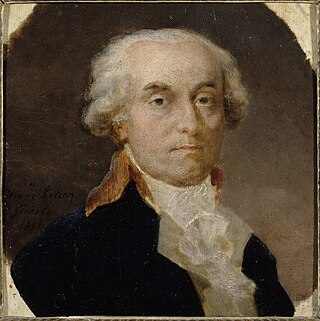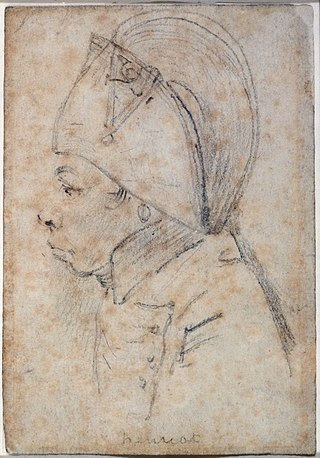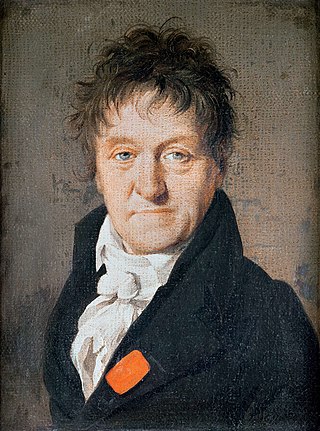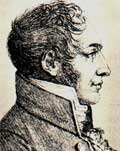
Charles-François du Périer Dumouriez was a French military officer, minister of Foreign Affairs, minister of War in a Girondin cabinet and army general during the French Revolutionary War.

Jérôme Pétion de Villeneuve was a French writer and politician who served as the second mayor of Paris, from 1791 to 1792, and the first regular president of the National Convention in 1792. During the French Revolution, he was associated with the moderate Girondins, and voted against the immediate execution of Louis XVI at the king's trial in January 1793, though he supported a suspended sentence. This led to Pétion's proscription by the Convention alongside other Girondin deputies following the radical insurrection of 31 May – 2 June 1793, and ultimately his suicide together with fellow-Girondin François Buzot while evading arrest during the Terror.

The Mountain was a political group during the French Revolution. Its members, called the Montagnards, sat on the highest benches in the National Convention.

Jacques-Nicolas Billaud-Varenne, also known as Jean Nicolas or by his nicknames, the Righteous Patriot or the Tiger, was a French lawyer and a major figure in the French Revolution. A close associate of Georges Danton and Maximilien Robespierre, he was one of the most militant members of the Committee of Public Safety, and is often considered a key architect of the Reign of Terror.

Jean-Marie Collot d'Herbois was a French actor, dramatist, essayist, and revolutionary. He was a member of the Committee of Public Safety during the Reign of Terror and, while he saved Madame Tussaud from the Guillotine, he administered the execution of more than 2,000 people in the city of Lyon.

Jean-Baptiste Louvet de Couvray was a French novelist, playwright and journalist.

François Hanriot was a French Sans-culotte leader, street orator, and commander of the Garde Nationale during the French Revolution. He played a vital role in the Insurrection of 31 May – 2 June 1793 and subsequently the fall of the Girondins. On 27 July 1794 he tried to release Maximilien Robespierre, who was arrested by the Convention. He was executed on the next day – together with Robespierre, Saint-Just and Couthon – by the rules of the law of 22 Prairial, only verifying his identity at the trial.

Maximilien François Marie Isidore de Robespierre was a French lawyer and statesman who became one of the most widely known, influential, and controversial figures of the French Revolution.

Lazare Nicolas Marguerite Carnot was a French mathematician, physicist, politician and a leading member of the Committee of Public Safety during the French Revolution. His military reforms, which included the introduction of mass conscription, were instrumental in transforming the French Revolutionary Army into an effective fighting force.
Jean-Claude-Hippolyte Méhée de La Touche (1762-1826) was the son of a surgeon in Meaux. Destined to succeed his father, he nevertheless left his home for Paris when he was 12, and ended up in the Bicêtre Prison. He was released at the coronation of Louis XVI of France in 1774, but in 1776, after the death of his parents, Méhée was again imprisoned in the Bicêtre. He escaped when he was sent to Brest to serve on the French fleet. He returned to Paris and was sent to Saint Petersburg as a spy under the name Chevalier de La Touche by Honoré Gabriel Riqueti, comte de Mirabeau and Gilbert du Motier, marquis de Lafayette. He was soon uncovered and was sent out of Russia in March 1791. His next appointment as a spy was in Poland, where he established the Gazette de Varsovie, a French newspaper in Warsaw. Again his role as a spy was discovered, and he was banished from Poland as well.

Jacques-Alexis Thuriot, known as Thuriot de la Rosière, and later as chevalier Thuriot de la Rosière, chevalier de l'Empire was an important French statesman of the French Revolution, and a minor figure under the French Empire of Napoleon Bonaparte.
André-Joseph Panckoucke was a French author and bookseller. He was the first of the Panckoucke family directly or indirectly involved in French publishing.

Pierre Joseph Duhem was a French physician and politician.
Joseph-François-Nicolas Dusaulchoy de Bergemont was a French playwright, writer and journalist.
Pierre Antoine Jean-Baptiste Villiers was a French playwright, journalist and poet.
Alexandre-Louis-Bertrand Robineau, called de Beaunoir, was an 18th-century French playwright.
Jean-François-Marie d'Arquier de Barbegal (1761–1794), also known as de Baumelles, parliamentarian from Aix in the 18th century, was involved in the federalist movement of 1793 during the French Revolution.
René-François Dumas, born 14 December 1753 in Jussey, in the bailiwick of Amont, was a revolutionary French lawyer and politician, regarded as a "Robespierrist", who died on 28 July 1794 at Paris.
Charles Hyacinthe Leclerc de Landremont was the commander in chief of the Rhine in 1793 during the French Revolution. He was also a descendant of the painter Jean LeClerc.










